|
|
|
Sort Order |
|
|
|
Items / Page
|
|
|
|
|
|
|
| Srl | Item |
| 1 |
ID:
176796
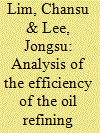

|
|
|
|
|
| Summary/Abstract |
This study investigated the efficiency of the oil refining industry using the two-stage method of Markowitz portfolio optimization theory and panel data analysis of about 30 OECD countries from 2005 to 2016, which is a new methodology for measuring the efficiency of the oil industry. The oil refining industry's efficiency is derived from the prices of petroleum products (Naphtha, Gasoline, Kerosene, Diesel, and Fuel Oil) using the portfolio theory. The panel data was constructed using the following dependent variables, the crude oil production efficiency, energy consumption, renewable energy consumption, and R&D investment. Using the panel data analysis, empirical analyzes are conducted on how the efficiency of the oil refining industry is affected by explanatory variables. The results show that crude oil production and energy use in OECD countries have a negative effect on the efficiency of the oil refining industry, and consumption of renewable energy and R&D investment have a positive effect. Contrary to conventional perception, the petroleum industry can coexist with the renewable energy industry for sustainable development.
|
|
|
|
|
|
|
|
|
|
|
|
|
|
|
|
| 2 |
ID:
176801
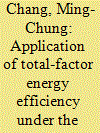

|
|
|
|
|
| Summary/Abstract |
As the computation of total-factor energy efficiency (TFEE) is not workable under the metafrontier framework since the metafrontier cannot fully envelope each group frontier, this research provides a new computation mode to solve this problem. Following a discussion on the methodology, we conduct empirical analysis on 28 member countries in the European Union (EU) and then divide them into Baltic sea region (BSR) countries and non-Baltic sea region (NBSR) countries for metafrontier analysis, thus contributing to the literature by presenting an available mode for TFEE analysis under the metafrontier framework. The suggested mode herein operates so successfully that all computation scores exhibit a reasonable scope. In addition, the BSR's average energy efficiency performs better than NBSR's, but the latter is still a technology exporter compared to the former. This paper summarizes the conditions for sustainable energy development: (i) set more serious energy efficiency targets; (ii) reduce primary and final energy consumptions, lower energy dependence on energy imports, and increase the share of renewable energy sources to fossil fuel energy sources; (iii) achieve a liberalized energy market; and (iv) set reasonable energy prices by levying an energy tax in order to realize effective energy consumption.
|
|
|
|
|
|
|
|
|
|
|
|
|
|
|
|
| 3 |
ID:
176815


|
|
|
|
|
| Summary/Abstract |
This paper seeks to analyse and propose alternative procedures to estimate the cost of equity through the capital asset pricing model (CAPM) in the context of electricity transmission in Brazil. Under the assumption that a stable beta is important for regulatory purposes since it provides institutional security for investors, as well as fair tariffs for consumers, we test different options to find the set of parameters that provides the most stable beta for the transmission sector. This paper is prescriptive in nature and attempts to offer alternative options for the cost of equity estimation, without changing the theoretical framework (i.e., CAPM) proposed by the Brazilian regulator. To pursue our aim, we test beta stability by modifying three CAPM elements: the risk asset, the proxy for market returns, and the length of the estimation window. By applying robust structural break tests, we show that the desirable beta stability may be reached with the use of a Brazilian pure-play global beta estimated with an 11-year estimation window.
|
|
|
|
|
|
|
|
|
|
|
|
|
|
|
|
| 4 |
ID:
176793


|
|
|
|
|
| Summary/Abstract |
The accessibility and reducing cost of distributed renewable energy sources are stimulating the emergence of small-scale residential prosumers who can produce and consume electricity. This may lead to various scenarios. Such prosumers may increase the uncertainty of consumption behavior, reduce consumption from the grid, and eventually disconnect from the grid. However, they may remain connected, and their energy potential can provide flexibility for the overall system. Current policy in some jurisdictions promotes disconnection through tax increases, grid charges, and other non-commodity costs. In particular, in Ontario (Canada) only 8.7% of the typical electricity bill covers the cost of energy and power; the remainder subsidizes governmental energy-procurement contracts, compensates the grid, pays for environmental initiatives, and covers other taxes. The situation is aggravated by a lack of a global vision for the energy system and of coordinated actions to achieve this vision. We support the preferred scenario in which prosumers remain connected to the grid. As an alternative to Ontario's current attempts to artificially slow the increase in electricity prices, we present an extended critical survey of energy policies to motivate a thoughtful reconsideration of current schemes for the economic integration of prosumers in the energy system.
|
|
|
|
|
|
|
|
|
|
|
|
|
|
|
|
| 5 |
ID:
176819


|
|
|
|
|
| Summary/Abstract |
Civil nuclear cooperation is a part of China's Belt & Road Initiative (BRI). Although the complex nature of nuclear technology and scale of the BRI program are likely to have substantial influences on the global nuclear landscape, research regarding the BRI nuclear cooperation is scarce. Given that paucity, our article aims at providing a fuller understanding of the program and policy implications. Distinctive parts include the BRI's economic dirigisme and new norms reflected to this nuclear cooperation, which draw a range of implications to the global nuclear future. Noting that the value of “win-win” is at the center of the BRI, this research highlights the need for a practical approach in the BRI nuclear cooperation and more emphasis on renewable energies. The roles of international community and regulators in the changing global nuclear market are also discussed.
|
|
|
|
|
|
|
|
|
|
|
|
|
|
|
|
| 6 |
ID:
176817
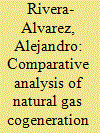

|
|
|
|
|
| Summary/Abstract |
An analysis to assess the influence of country-dependent variables and incentives on the feasibility of natural gas cogeneration projects in Latin America is presented in this work. The analysis is performed using a hypothetical industrial plant, where the cogeneration solution consists in the recovery of waste heat from the power generation for steam production. The feasibility is evaluated by calculating the Return of Investment (ROI) and the Internal Rate of Return (IRR) of the project. Eight Latin American countries are studied considering their specific natural gas markets, regulation, and macroeconomic variables. Two scenarios, electricity production for self-consumption and electricity production with power surplus sale, are independently analyzed considering the effects of available incentives. In the countries where the project is feasible, the application of incentives leads to a significant reduction in the ROI and, consequently, to an increment in the IRR. The effect of the interest rate and environmental impact were also analyzed. In general terms, along the region, the regulation for cogeneration is incipient while incentives are very standard and similar respect to lowering of import, Value-Added Tax (VAT), and income taxes, which seems to be designed purely to promote capital investment. Following the results from this study, it is of paramount importance to create new policy instruments in the future to advance the regulatory framework for cogeneration in Latin America.
|
|
|
|
|
|
|
|
|
|
|
|
|
|
|
|
| 7 |
ID:
176785


|
|
|
|
|
| Summary/Abstract |
Whether there will be a long-run equilibrium (steady state) in energy demand per capita is a critical question for energy and environmental policy makers. While many studies have been done on energy production and energy consumption, little attention has been paid to whether disparities in relative household energy consumption (RHEC) converge, and how the use of aggregated data has serious limitations. This paper is the first study to investigate the convergence and dynamics of household energy consumption in China. The results are helpful to Chinese policy makers when trying to identify the key groups for priority interventions. The study finds that variability in the RHEC is very high and that many households will likely change their energy consumption patterns in the coming years. Overall, Chinese households have two convergence clubs. The current dynamics will probably lead to lower energy consumption for most households. The study suggests that policy makers should pay particular attention to households that have too low or too high RHEC level, mainly in rural areas and in the western region.
|
|
|
|
|
|
|
|
|
|
|
|
|
|
|
|
| 8 |
ID:
176825


|
|
|
|
|
| Summary/Abstract |
This paper introduces an innovative line of study to the current literature, by assessing the interactions, in France, between electricity sources, and periods with differing electricity consumption; namely morning off-peak, morning peak, middle off-peak, and night peak, using high-frequency data, specifically, daily data. This paper also analyses the impact of these interactions on both the diversification of the electricity mix, and on carbon dioxide emissions. Thus, this research could help identify the conditions needed, in both supply and demand, for a successful transition towards renewable energies. A Vector Autoregressive model has been employed to detect the presence of endogeneity, and to show the interactions between electricity supply and demand. Consumption in France has been problematic for the management of a portfolio containing rigid and intermittent base load sources. High peak consumption at night has increased the necessity to deploy a flexible electricity generating source, in other words, fossil fuels, and is one of the reasons for nuclear de-activation. In comparison, high morning peak consumption is rational and desirable. Indeed, morning peaks have been satisfied by a portfolio of renewable energies, decreasing the harmful impact of electricity on the environment, and keeping electricity costs low.
|
|
|
|
|
|
|
|
|
|
|
|
|
|
|
|
| 9 |
ID:
176792


|
|
|
|
|
| Summary/Abstract |
Governments use procurement auctions for renewable energy support to stimulate investment in renewable energy. The main challenge in auction design is the balance between cost-efficient procurement and high post-auction realization, i.e., effective procurement. I empirically assess the effect of prevalent auction design elements on effectiveness, using a unique dataset with results of auctions for renewable energy support from 1990 to 2017. I find that pre-qualifications and penalties drive realization rates, while technological banding or the pricing rule do not affect effectiveness. The former is in line with existing theory, while the latter sheds new lights on auction models and case studies discussing auction outcomes, as literature has thus far broadly agreed on a major influence of all design elements. According to my results, policy makers which focus on high realization rates should include pre-qualification measures and penalties into their design. Importantly, policy makers gain more degrees of freedom regarding other design features to tailor renewable energy auctions to their country. This freedom is advantageous in view of a large variety of countries adapting renewable energy auctions.
|
|
|
|
|
|
|
|
|
|
|
|
|
|
|
|
| 10 |
ID:
176831


|
|
|
|
|
| Summary/Abstract |
The decarbonisation of heating represents a transformative challenge for many countries. The UK's net-zero greenhouse gas emissions target requires the removal of fossil fuel combustion from heating in just three decades. A greater understanding of policy processes linked to system transformations is expected to be of value for understanding systemic change; how policy makers perceive policy issues can impact on policy change with knock-on effects for energy system change. This article builds on the literature considering policy maker perceptions and focuses on the issue of UK heat policy. Using qualitative analysis, we show that policy makers perceive heat decarbonisation as disruptive, technological pathways are seen as deeply uncertain and heat decarbonisation appears to offer policy makers little ‘up-side’. Perceptions are bounded by uncertainty, affected by concerns over negative impacts, influenced by external influences and relate to ideas of continuity. Further research and evidence on optimal heat decarbonisation and an adaptive approach to governance could support policy makers to deliver policy commensurate with heat decarbonisation. However even with reduced uncertainty and more flexible governance, the perceptions of disruption to consumers mean that transformative heat policy may remain unpopular for policy makers, potentially putting greenhouse mitigation targets at risk of being missed.
|
|
|
|
|
|
|
|
|
|
|
|
|
|
|
|
| 11 |
ID:
176786


|
|
|
|
|
| Summary/Abstract |
Since 2015, the Government of the Czech Republic has adopted some decisions that have altered the prospects for coal mining. In 2015 it adjusted its mineral and energy policy by allowing for lignite to be mined in a part of the North Bohemian Basin that was blocked by a political decision driven by the environmental reasons in 1991. An updated state energy policy came into force in 2015, and the government approved a new Mineral Policy of the Czech Republic in 2017. Based on these new data, it is possible to compare the coal mining concept, energy mix, and energy dependence in the Czech Republic with selected EU Member States, specifically Poland and Germany. The analysis shows that the prospects for coal use in the European Union are not only influenced by the amount of coal production in the EU Member States but also by the amount of coal imported to individual EU countries. It is also anticipated that the future of European coal production will not only be determined by geological, mining technology and economic criteria but rather by the increasingly important role of political decisions.
|
|
|
|
|
|
|
|
|
|
|
|
|
|
|
|
| 12 |
ID:
176794
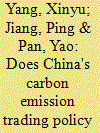

|
|
|
|
|
| Summary/Abstract |
The implementation of China's carbon emission trading policy has targeted achieving emission reduction and environmental protection as well as promoting economic development and technological innovation. The analysis is made through applying the Difference-in-Differences model and using the Ordinary Least Squares method and the Least Square Dummy Variable method in the paper. Results show that the pilot carbon emission trading policy leads to the expansion of employment scales and the reduction of carbon emissions after controlling for the environmental regulation, population size, economic level, and other important variables. Thus, it implies that an employment double dividend exists. For the Porter effect, it is found in the pilot carbon emission trading policy only without adding any control variable. The effect is further verified based on a robustness checks and a placebo test. Furthermore, from the perspective of market-oriented environmental regulation policy, this study explains that the carbon emission trading system launched in 2017 needs to be improved to spread both the employment double dividend and the Porter effect to the whole nation. China also needs to form a complete set of strict ecological environment protection policies and administrative measures to achieve sustainable development of the economy.
|
|
|
|
|
|
|
|
|
|
|
|
|
|
|
|
| 13 |
ID:
176798
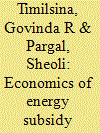

|
|
|
|
|
| Summary/Abstract |
As in many countries around the world, subsidies to energy in Bangladesh impose a significant fiscal burden, with benefits that disproportionately accrue to high-income households. Using a computable general equilibrium model, this study investigates the economy-wide impacts of the removal of direct subsidies in the electricity sector and indirect subsidy in natural gas in Bangladesh. The study finds that the removal of energy subsidies would be beneficial to the economy and would increase GDP. The magnitude of the economic impact depends on how the budgetary savings from the removal of electricity subsidy and the increased revenues due to the removal of indirect subsidies to natural gas are reallocated to the economy. Recycling the savings (or the new revenues) to fund investment would benefit the country most, followed by the case of utilizing them to fund cuts in income taxes, and finally to fund cuts in indirect taxes. While the reallocation of budgetary savings to households through lump-sum transfers is found inferior to other recycling options considered, it could be the preferred from the distributional perspective. However, further analysis is needed to confirm this.
|
|
|
|
|
|
|
|
|
|
|
|
|
|
|
|
| 14 |
ID:
176827
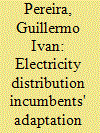

|
|
|
|
|
| Summary/Abstract |
The transition to a cleaner and smarter electricity system is being spurred by new policy approaches aiming at delivering a decentralized, digital, and decarbonized energy future. This calls for the adaptation of incumbent technologies, policies, and actors, as well as for the introduction of new system components. The changing role of electricity distribution systems, and of distribution system operators, has been a focal aspect of recent market design efforts, given the critical role of network infrastructure and the importance to adjust its operations, and regulatory framework. We build on a novel dataset from 124 DSOs and apply a methodology combining Factor analysis and a Tobit model to evaluate the role of market, regulatory, investment, and firm-level factors on technological, business model, and market design adaptation. Our results indicate that hybrid regulatory models contribute to DSOs adaptation. Investing in smart grids is found to have a positive effect on adaptation. Regarding firm-level characteristics, the results indicate that unbundling does not affect adaptation, however larger DSOs are found to be better able to adapt. These findings provide timely empirical evidence for advancing regulatory and policy approaches toward the adaptation of incumbents in a rapidly changing electricity sector.
|
|
|
|
|
|
|
|
|
|
|
|
|
|
|
|
| 15 |
ID:
176799


|
|
|
|
|
| Summary/Abstract |
A major concern with electricity market restructuring has been the possibility that fuel price volatility may leak into electricity prices. This view is credible if electricity price – fuel costs relation is stronger in restructured than in non-restructured states. We examine the validity of this view using panel data on for industrial, residential and commercial sectors in US states. The analysis accounts for cross-sectional dependency, cross-state heterogeneity, and interdependency of state fuel markets. The common correlated effects mean-group estimates suggest that (1) coal and natural gas costs Granger-cause electricity prices for industrial and commercial customers in both non-restructured and restructured states; (2) both fuel costs also Granger-cause electricity prices for residential customers in non-restructured states but only natural gas costs cause electricity prices in restructured states; (3) the long-run impacts of fuel costs on electricity prices are higher in non-restructured than restructured states; and (4) electricity prices exhibit lower persistence in non-restructured than in restructured states. These results are do not support the view of higher integration between input costs and electricity prices in restructured markets. Policymakers should be aware of the differences in electricity price response in alternative market structures when implementing new federal policies.
|
|
|
|
|
|
|
|
|
|
|
|
|
|
|
|
| 16 |
ID:
176809


|
|
|
|
|
| Summary/Abstract |
Changing climate creates energy demand uncertainty that is essential for facility and organizational management. Energy conservation can be achieved through combinations of capital improvements and/or management strategies. One such management strategy is implementation of non-conditioning zones to reduce temperate season energy demand. In this study, we evaluate a temporally-based, non-conditioning zone policy originally developed for Kunsan Air Force Base, Korea and apply it to six locations across the contiguous United States, which coincide with major U.S. Air Force bases in various climate zones. Using projected temperature portfolios, we determine that the performance of the implemented policy is likely to change over the remainder of the century. In temperate climate zones, there is an increase in the potential non-conditioning zone by about a month. However, in a tropical climate, the potential duration for a non-conditioned zone reduces by over half by the end of the century. In addition to non-conditioning zone duration change, temporal shifts in the spring and fall seasons affect non-conditioning zone onset. The cumulative changes suggest the need for climate forecast-informed adaptive management policies to mitigate energy demand. The results of this study inform organization and facility-level energy management, suggesting adaptive management policies to address energy budget uncertainty.
|
|
|
|
|
|
|
|
|
|
|
|
|
|
|
|
| 17 |
ID:
176813


|
|
|
|
|
| Summary/Abstract |
Previous studies analyzing energy related nitrous oxides (NOx) focus on the calculation and influencing factors of NOx generation, but lack sufficient analysis of policy impacts. This paper attempts to evaluate a critical financial incentive for motivating NOx removal in China – the denitrification tariff for power plants. We calculate energy-related NOx generation in 30 provinces from 1995 to 2016, and test the impact of the denitrification tariff using an extended STIRPAT (Stochastic Impacts by Regression on Population, Affluence, and Technology) model. We examine policy impacts in the pilot and follower regions with different implementation time, and find significant reduction in NOx generation in both regions. On national average, our model estimates that 1% increase in the denitrification tariff leads to 0.190% decline in energy-related NOx generation, holding other variables constant. The effect size of the tariff is higher in the follower region than in the pilot region, whereas policy effect is lagged for 2 years in the pilot region. We also find socio-economic factors significantly positively correlated with NOx generation. The result suggests that tailored incentives considering regional disparities will work better than a uniform incentive, and a combination of policy instruments in reducing fossil fuel consumption is desired to effectively reduce NOx generation.
|
|
|
|
|
|
|
|
|
|
|
|
|
|
|
|
| 18 |
ID:
176804
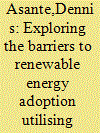

|
|
|
|
|
| Summary/Abstract |
Renewable energy sources development has become popular in recent times for their energy security, employment creation and containment of greenhouse gases emissions. However, the development of renewable energy in developing countries has remained stagnant despite plenteous renewable energy sources due to existential barriers. Herein, using Ghana's renewable energy policy target of 10% other renewables besides hydroelectricity in her total energy mix by 2020 as a case analysis, this study identified and ranked the barriers to renewable energy development. Overall, twenty-three barriers were finalised and categorised under six broad headings, including technical, economic and financial, social, political and regulatory, institutional, and geographical. Subsequently, the proposed Multi-Objective Optimisation based on Ratio Analysis (MULTIMOORA) integrated with the Evaluation based on Distance from Average Solution (EDAS) method was applied to rank barriers and sub-barriers. The political and regulatory barriers ranked highest among the six categories, while corruption and nepotism emerged as the most critical hurdle within the sub-barriers. The findings suggest that specific renewable energy standards, grid connection quotas and simplification of certification procedures are required. A bottom-up approach to renewable energy policy formulation is preferable for inclusiveness and sustainability. Moreover, the paper has developed a framework for the assessment of how each barrier impedes renewable energy development.
|
|
|
|
|
|
|
|
|
|
|
|
|
|
|
|
| 19 |
ID:
176822


|
|
|
|
|
| Summary/Abstract |
Pilot-, test- and demonstration-projects (PTDs) are a prominent policy tool to promote the adoption of smart, green technologies. However, as technology adoption is heavily dependent on the individual attributes and beliefs of potential adopters, it is important to understand the influence of a PTD's organizational setup on technology perception. By varying the information about a PTD's organizational setup in a survey experiment among a selected sample of potential PTD-participants, we gather first experimental evidence for the effect of different setups on the perception of green technologies. We show that the organizational setup has a significant impact on a product's perceived contribution to the energy transition, its establishment in the market, cost-reduction potential, innovativeness and environmental friendliness. In particular, full organizational cooperation between government, university and industry consistently improves perceptions compared to a partial setup. Regarding the willingness to participate in a PTD, we find that communication and support are the most imperative aspects and even more important than economic benefits. Our findings provide policy-makers with a more ample foundation on how PTDs should be designed to successfully transfer technologies to the market.
|
|
|
|
|
|
|
|
|
|
|
|
|
|
|
|
| 20 |
ID:
176814


|
|
|
|
|
| Summary/Abstract |
Environmental and technical efficiency in the electricity sector is a major focus of regulatory policies aimed at hastening greenhouse gas reduction and lowering energy prices for final consumers. Understanding the impact of market and environmental regulations on efficiency is crucial for the design and choice of policy packages. At the national level, the productivity response to regulations depends on unobserved country-specific factors that current empirical analyses have not modelled. In this framework, we analyse the regulation effects on efficiency in the electricity sector for a panel of European Union countries. We explicitly consider the effects of the environmental regulation along with the market regulation. Our estimation strategy uses the Bayesian shrinkage estimator, which can deal with the bias aggregation problem and cross-country heterogeneity. It allows us to identify the different transmission channels through which regulatory policy is implemented. The results highlight divergent behaviours at the country level. The direct impacts of the market and environmental regulatory policies on productivity are negative—around −2.7% and −2.3%, respectively—but the countries vary in the degree to which they are able to compensate these negative effects.
|
|
|
|
|
|
|
|
|
|
|
|
|
|
|
|
|
|
|
|
|